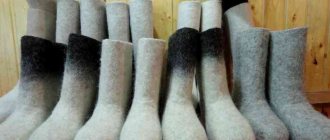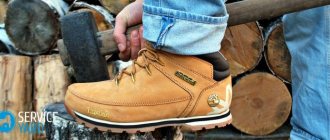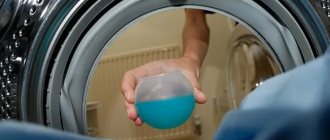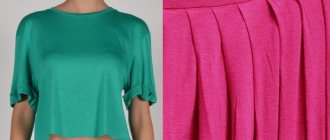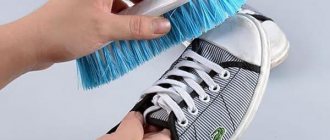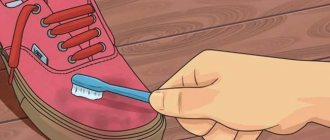Humanity learned to make felt between the 5th and 6th centuries BC. Around this time, sheep were domesticated, the wool from which it is made.
In the modern world, products made of dense, warm material are widely used. Felt, a type of felt, is used to sew outerwear, accessories and bags. Caring for them requires compliance with certain rules. Cleaning, drying and storage of the material must be appropriate to its characteristics.
Characteristics and varieties
When considering the properties of a material, you should not ignore the technology of its manufacture. Felt is called fabric rather arbitrarily, because it is not woven. The production technology consists of dry or wet felting.
This process is made possible by the scaly structure of sheep wool. The fibers are tightly woven together, creating a dense and fairly hard material.
Based on the thickness and type of raw material, felt is divided into several varieties:
Technical
Types of felt
This type of material is used in the manufacture of substrates for linoleum, thermal insulation work and various types of filters. The cheapest types of natural wool or synthetic fibers are used as raw materials.
Felt
Hats, classic coats, bags and even shoes are made from it. The basis for felt can be either sheep wool, rabbit or goat wool. Raw materials are taken only of the highest quality, which makes the finished products soft and easy to take the desired shape.
Needle-punched fabric
Its second name is furniture felt. It is a type of technical, but with a softer texture.
Shoe
What is shoe felt?
Thick and dense material serves as the basis for stylish and warm felt boots and high boots. In addition to shoes, this type of felt is used in the manufacture of insoles.
Yurt
The self-explanatory name of the canvas accurately indicates its purpose. For centuries, the peoples of the far north and nomadic tribes have been using yurt felt to create yurts, folding huts suitable for habitation.
ARTICLE FOR YOU
How to properly wash staple clothes and linen: in a washing machine and by hand
The material has an impressive list of advantages, the main ones include:
- strength and wear resistance;
- thermal insulation;
- good absorption of excess moisture;
- antibacterial effect;
- resistance to deformation.
Felt is resistant to deformation.
In addition, felt is considered a natural and environmentally friendly material. And the unique combination of frost resistance and lightness is proven by the popularity of felt boots.
Shoe and insoles care
It is important to regularly and promptly clean, air and dry your shoes. Cleaning is done after every wear. Wash your shoes, boots or shoes thoroughly with a damp cloth, clean with a dry microfiber cloth, dry and ventilate.
Follow proper cleaning, drying and storage instructions. Many materials do not like large amounts of moisture, exposure to ultraviolet radiation and electrical appliances, or large temperature changes. Never leave wet shoes after wearing them! Dry items under natural conditions.
We treat dry shoes with shoe polish or spray. For the inside and insoles, use a special foam or deodorant. After treatment, you should not immediately go outside. It is important that the compounds are absorbed and dry. How to dry shoes properly and quickly, read the link https://vsepodomu.ru/garderob/kak-bystro-vysushit-obuv/.
In addition to daily care of your sneakers, general cleaning is required. Unfortunately, many people leading an active lifestyle do not know how to properly wash sports shoes.
This is necessary not only for the durability and wear resistance of the products, but also to protect the feet from the development of various fungal diseases. It is not enough to go over with a soapy sponge to remove the bulk of the dirt. It is necessary to carry out general cleaning more often.
Washing rules
Items made from felted wool can only be washed if absolutely necessary. If this is not available, you should limit yourself to dry cleaning. If the product is heavily soiled or has a general loss of presentable appearance, then washing is quite difficult to avoid.
The following rules will help you avoid damaging the material:
- the water temperature should be within the range of 30-40 degrees;
- rubbing or subjecting to intense mechanical stress is strictly prohibited;
- industrial bleaches are not applicable;
- detergents must match the type of material;
- Spinning and machine drying are prohibited;
Hand washing felt
These recommendations are aimed at preserving the original gloss and quality of felt products. Compliance with them will significantly extend the service life.
How to clean
So how do you properly keep your orthotics clean? It all depends on the material from which they are made:
- The leather insole is instantly deformed by machine washing. To disinfect such products and remove dirt, use a soft cloth and a weak alcohol solution. Another cleaning and disinfectant is hydrogen peroxide. Let’s assume an option with a slightly pink solution of potassium permanganate.
- Felt and suede insoles can be gently wiped with soapy water. Use soft sponges and brushes.
- Never use boiling water or completely immerse the product in water! The use of chlorine-based bleaches is prohibited.
- Wash soft insoles from sneakers, such as Ecco, in a machine on a delicate cycle. Water temperature - up to 30 degrees. Spin - at minimum speed, or without spin at all.
- There are special cleaning foams for insoles and shoes. Apply them and remove them after the time specified in the instructions.
Rules for caring for silicone insoles “Shol”:
- They are washed in warm (not hot!) soapy water.
- Do not use chlorine-containing products.
- After washing, the insoles are blotted using hygroscopic fabric.
- Drying is carried out naturally, without batteries, hair dryers and sun.
Dry cleaning
Traces of dust and minor dirt are removed without using large volumes of water. In this way you can clean felt boots, hats, coats or any other felt products that cannot be washed. To carry out dry cleaning, you will need a medium-hard brush and a damp cotton cloth.
The procedure itself is carried out in several stages:
- using a brush, the entire surface of the product is processed;
- stains are removed with wool stain remover or using a suitable method from scrap materials;
- You can refresh the felt after treatment with a well-wrung cotton napkin.
Soap foam will remove heavy dirt; it is applied locally and removed with a sponge after a few minutes.
Felt products are suitable for dry cleaning
An interesting way to clean using bread. Dry crusts are rubbed onto the dirty surface. The remaining bread and crumbs are swept away with a brush. Felt boots can be cleaned well in this way.
Cleaning stains
Natural and artificial leather cleans quickly. Simply wash the stained area with a damp cloth.
Cloth sneakers quickly absorb various dyes, forming stains on the surface. This applies to suede and nubuck.
You can clean your sneakers using special foam or home remedies. Both methods are effective when removing fresh stains.
Simple products that remove various types of contaminants:
- Suede Puma or Adidas are cleaned with baking soda and milk. 1 tbsp. l. Mix soda with 200 ml of low-fat milk. Rub the mixture onto dirty areas and remove excess with a wet sponge. This method is only suitable for white sneakers.
- Ammonia and hydrogen peroxide will save fabric shoes from yellow stains. Use the products together or separately. Dilute with water at the rate of 15 drops per glass of liquid. Use a piece of cloth soaked in the solution to treat the dirty fabric surface. No need to wash.
- You can clean the mesh on black or brown sneakers with coffee grounds, and white ones with soda and salt. After washing in a machine.
- It is easier to remove stains from winter sneakers than to completely soak them. The first will reduce drying time, and not everyone has several pairs of such shoes. Oily stains can be removed with dishwashing detergent, grass stains can be removed with ammonia and laundry soap, and soot can be removed with turpentine diluted with water.
Handwash
Cleaning by hand will gently and gently remove dirt and stains from delicate materials. For washing, you will need a container of a suitable size and detergent for wool.
ARTICLE FOR YOU
How to properly wash drape clothes: in the washing machine and by hand
The process itself consists of several steps:
- the detergent composition is mixed with water;
- the temperature of the solution should not exceed 40 degrees;
- the product is soaked for one hour;
- if there are any dirt left after soaking, they need to be gently rubbed together with your hands;
- Remaining soap and dirt must be rinsed with plenty of water;
- You cannot wring out the felt; the water should drain naturally.
When wet, the adhesion of wool fibers weakens significantly. It becomes easy to stretch and deform. Strict adherence to the above recommendations will help you avoid loss of shape and shrinkage.
How to wash the sole
The cleanliness of sneakers depends on the quality of the polyurethane on sports models. Poor quality material gets dirty faster, especially in industrial cities, the sole becomes gray-yellow in color.
12 ways to return whiteness:
- Rub with a stationery eraser. Rub dirty areas with strong pressure. When soiled, the top layer of the eraser is cut off with a utility knife.
- Dilute bleach with water in a ratio of 1:2. Wearing gloves and armed with a rag, vigorously rub the sole. Rinse with clean water and dry.
- Use a melamine sponge. The innovative product can cope with any contamination. Moisten the sponge with water and press it with your palms to remove excess moisture. Rub the sole with the tip.
- Tooth powder and toothpaste are excellent whiteners. Do not use with abrasive particles, the material will be scratched. Wet the sole, apply the product, and rub. Leave for 10 minutes, rub thoroughly again with a toothbrush and rinse.
- Nail polish remover will return the sole to its former whiteness. Soak a soft cloth with acetone and wipe dirty areas. Wash the sole well under running water.
- Citric acid is applied with a damp brush. Rub and wash off. Repeat until the desired result is obtained. An alternative to citric acid is vinegar essence.
The final result depends on how often you clean the sole and how quickly you remove stains. It is better to use an old toothbrush; its bristles are thicker and penetrate into all hard-to-reach places.
Whitening sneakers
Washing in a washing machine
Most manufacturers of felt and felt products do not recommend machine washing. When deciding to wash these items, you need to be aware of the possible consequences. These include rapid wear of the material, loss of shape, and significant shrinkage.
Machine wash is not recommended for felt items.
If you are ready to take a risk, you should adhere to the following rules:
- the water temperature should not exceed 40 degrees;
- select the delicate wash mode;
- Don’t skimp on the air conditioner;
- spinning and machine drying are strictly prohibited;
- The extra rinse feature won't hurt.
When removing things from the drum, they must be straightened out and the water drained on their own.
Types of sneakers
There is more than one type of sports shoes. They are classified depending on their purpose. There are sneakers for basketball, football, running, tennis, skateboarding, trekking, skateboarding and fitness.
Washing sneakers in a bag
They are also classified by fabric type:
- mesh sneakers;
- fabric;
- suede;
- made of nubuck;
- leather;
- on fur;
- leatherette
When washing, the type of sneakers does not really matter. You should focus on the type of material from which they are made.
Detergents
To clean felt products, it is necessary to select appropriate products.
The household chemicals market offers a wide range of products for washing wool; the following options are the most preferable:
- specialized shampoos;
- soft gels and concentrates;
- laundry liquid soap;
- Shoes made of felted wool can be easily cleaned with carpet cleaning products;
- For hand washing, you can use dishwashing liquid or liquid hand cream soap.
Liquid laundry soap
The main criterion when choosing a cleaning composition is considered to be low alkali content, good foaming and solubility in water. Products containing lanolin are ideal for washing wool; this natural substance promotes gentle cleansing and makes the felt smoother and shiny.
How to choose wool shoes
The choice of similar products for daily wear involves a number of nuances:
- Felt boots, boots or slippers must be touched to evaluate how soft they are or vice versa.
Thus, high-quality shoes must remain firm, but it is recommended to slow down on the middle option. Very soft products do not hold their shape well, and too hard ones will rub your feet, which will become an obstacle to their everyday use.
The same applies to the sole - the heel must correspond to the size and shape of the heel, otherwise the comfort of wear will be in question.
The painted version fades from the inside and fades in the sun. In order not to get your socks dirty and to preserve the original quality of the shoes forever, it is better not to buy such a model. But for your home you can choose both options, because... none of them will be exposed to the outdoor environment.
Whitening
Felted wool does not withstand chemical bleaching well. It is extremely undesirable to use aggressive compounds, and especially chlorine, on it. But this does not mean that it will definitely not be possible to return whiteness.
ARTICLE FOR YOU
How to wash nylon clothes: in the washing machine and by hand
There are several effective remedies suitable for combating yellowness and gray tints:
- potato or corn starch;
- Wheat flour;
- crushed chalk;
- baking soda;
- semolina.
Starch is suitable for combating yellowness.
All of the listed products have absorbent functions. This allows them to be used on a dry surface. To achieve the result, they are simply applied to felt and left for several hours. After a while, the residues are brushed out or vacuumed.
How to properly wash orthopedic insoles?
Orthopedic insoles are carefully cleaned with brushes and wiped with damp cloths. Rags are moistened with alcohol solutions for leather and a weakly concentrated soap solution for textile materials. Remember that concentrated solutions of alkalis and acids cannot be used.
Interesting materials:
How to connect a flash drive to an ASUS tablet? How to connect a flash drive to a Huawei tablet? How to connect a flash drive to an iPad tablet? How to connect a flash drive to a Lenovo tablet? How to connect a flash drive to a router? How to connect a flash drive to Samsung S8? How to connect a flash drive to an Android smartphone? How to connect a flash drive to a virtual machine? How to connect a flash drive on a computer? How to connect a flash drive in Linux?
Drying
When drying, the wool can significantly decrease in size. This happens when the rules for drying capricious material are violated.
The following tips will help you avoid this problem:
- do not dry products in close proximity to heat sources;
- do not allow drying in direct sunlight;
- Felt items are dried flat, preferably horizontally;
- Shoes made of felted wool must be stuffed with paper;
- The drying room must have good ventilation.
It is not recommended to dry felt products near heat sources.
There is a little trick for removing excess moisture. You cannot wring out the felt, but you can slightly wrinkle it or press it onto a hard surface. This will remove water and speed up the drying process.
The nuances of cleaning slippers made of different materials
Before soaking your slippers, you need to pay attention to the material and then decide which type of wash to choose (hand or machine). You need to take care of your house shoes regularly and wash them at least 3 times a season.
From felt
Warm felt is an ideal material for winter indoor slippers. The density of felted wool makes it difficult to keep clean. To ensure that their properties are not lost during wearing, you need to wash felt slippers as follows:
- shake and knock out sand and debris, hitting the slippers with the soles against each other;
- Dilute wool washing gel in a container with water (30°C), or regular shampoo. Do not use washing powder;
- lather and leave to soak for 15 minutes;
- rinse twice, thoroughly removing any remaining detergents. The slippers are made using the hand felting process, so they cannot be stretched, twisted, rubbed or squeezed;
- as the water drains, place it on a towel, cover and press on the slippers in several places to absorb moisture;
- straighten it to its original shape. It is best to dry them on a special block to avoid deformation.
Keeping slippers in hot water shrinks and they can become unwearable, becoming like Thumbelina's slippers from a fairy tale.
This is interesting. In Japan, there is an ancient ritual of taking off your dusty traveling boots at the door and putting on soft slippers. This is how mental cleansing from worldly problems and complete immersion in a homely atmosphere of comfort occurs.
Suede
Soft velvety leather is not subjected to any washing. Spilled liquid on suede can be removed with a clean cloth and blot the stain. Leather treated with a water-repellent coating is wiped with a damp towel.
For suede, it is recommended to use a special cleaning kit. In general, you need to act like this:
- use a brush (nail file, fine-grained sandpaper) to erase traces of dirt and abrasion, restore the fleecy structure;
- wipe the inside with damp wipes until there are no remaining dirt on them;
- An alternative method of cleaning inside and out is a soapy solution made from liquid soap or shampoo. Use a cloth soaked in foam to clean the slippers with quick and light movements;
- give time for natural drying;
- Treat with a water-repellent agent to make cleaning easier in the future.
To remove greasy stains, shiny areas and other contaminants, you can use the same folk remedies as for caring for suede items.
Leather conditioner will add softness to the slippers. It must be used according to the recommendations on the packaging.
Ironing
Dried wool can be ironed, but with certain precautions. These include the following items:
- iron the product while still a little damp, this will reduce the risk of shrinkage;
- the iron temperature should be between 130-160 degrees;
- it is necessary to iron the felt through the fabric;
- It is recommended to use the steam function.
Ironing will not only give the product a neat appearance, but will also allow it to dry faster.
Is felt washable?
Natural and eco-friendly felt is a rather capricious material made from sheep wool, but very warm and cozy. Felt is mistakenly called fabric - it is made by dry or wet felting, rather than woven.
Felt home slippers are valued for their aesthetics and some healing properties: wool relaxes feet after a hard day and warms them. High boots and felt boots, as well as insoles, are made from shoe felt.
You need to care for felt slippers in the same way as other household clothing. Feel free to wash the product in a washing machine, but only according to certain rules.
For reference, you should not wear felt slippers in extreme heat, but at other times this is an ideal solution. Wool does not accumulate body heat, but only retains it, while allowing air to pass through - therefore, in properly sewn felt slippers, feet do not sweat or overheat.
How to wash felt slippers
Many people prefer soft and comfortable slippers, such as IKEA ones. Can natural materials be washed? Yes, sure. You just need to be responsible when choosing a cleaning method.
There are several options for washing felt slippers.
- To get rid of dust, soil or small debris, you can simply shake the shoes thoroughly or knock them out of the felt.
- To get rid of stains, new or old, you should use a carpet cleaner.
Washing is not recommended. Felt slippers can be washed 1-2 times a year.
Washing recommendations:
- If the shoe has a sole made of genuine leather or suede, then it needs to be torn off.
- You can soak your slippers in a solution of warm water and wool detergent for half an hour. Regular powder cannot be used.
- Hot water has a detrimental effect on the material.
- Do not wring out felt slippers. It is better to leave them so that excess water can drain off, and then gently blot them with a towel.
- Dry in its original form, without heat treatment.
When machine washing, you need to remove the sole and decor. The mode should be set to delicate. If available, it is better to set the special mode “For wool”. Spin needs to be turned off.
In what mode?
Each material requires a different temperature regime. Maximum temperature – 40 degrees. The less, the better - the thing ru notices that the material deteriorates from high temperatures.
When choosing a mode, you should give preference to “Delicate wash”, “Shoe wash” or “Hand wash”. This will allow you to carefully treat contaminated areas.
The main thing is to turn off the spin. Powerful mechanical processing can deform shoes. It is better to let the shoes dry on their own, excluding thermal effects. You can use paper, after crumpling it, place it inside the shoes. This method will get rid of excess moisture and help maintain the original shape of the shoes.
Can slippers be machine washed?
We put the slippers in a special bag for washing shoes. Some people ask: can slippers be washed in a machine just like that, without a bag. And we answer - definitely not! ... It is better to use washing gel, since it is easier to rinse and it dissolves faster.
Interesting materials:
How to register DNS on Windows 10? How to register an MX record on Reg ru? How to skip a line on the keyboard? How to germinate sunflower seeds at home? How to simply sew a belt to trousers? How is the Unified State Exam test checked? How do they check a taxi pass? How to check the authenticity of 200 euros? How to check an Android tablet? How to test a basketball?



